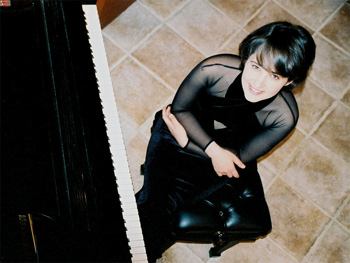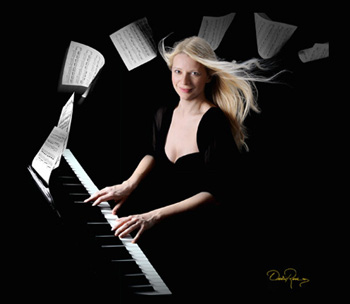Been to a piano recital lately?
Thanks to the dedication of the impresarios at the UCSC Arts and Lecture Series and the indefatigable John Orlando of Cabrillo College’s Distinguished Artists Concert and Lecture Series, I attended exquisite back-to-back piano recitals by Valentina Lisitsa and Halida Dinova in Santa Cruz last weekend.
And before you say, “Oh boy, a piano recital – how boring,” let me tell you that judging by the near sold-out shows at the UCSC Concert Hall and the Cabrillo College auditorium on both evenings, I would say that more than just the intelligentsia are responsive to the kind of intimate entertainment experience wonderful classical piano recitals like these can be.
But let me tell you about the performances.
Ukrainian-born Lisitsa and Russian-born Dinova were born and trained in Eastern Europe and are therefore strongly influenced by the highest standards of renowned Russian pianism dating back to Anton Rubinstein during the late 19th century. Despite the background they share, they are very different artists.
Valentina Lisitsa
Valentina Lisitsa, with her long blond hair, black gown and finely muscled white arms, looked and sounded like the quintessential bravura pianist. Boasting a big rich sound, she hardly dropped a note as she exploded into the opening salvo of the riveting Rachmaninoff Etude Tableau Op. 39, No. 6. This was followed by a group of the more popular Preludes, including the wistful G Major of Op. 38 and the martial G minor of Op. 23 with its typically ‘Rachmaninoffian’ dreamy middle section. (Coincidentally, this pairing of G Major and G minor Preludes was unwittingly programmed by both pianists. Both were wonderfully played. It is a matter of taste as to which one might prefer, but I was partial to the more lucid transparency of Halida’s interpretation of these.)
Lisitsa’s powerful performance of Beethoven’s Appassionata Sonata Op. 53 left the audience bedazzled; at intermission, we walked around the lobby praising her commanding technique and musicality.
Schumann’s Kinderszenen (Children’s Scenes), Op. 15 was a welcome contrast after a moody and tempestuous first half. Kinderszenen consist of 12 short reflections by a grown man looking back on childhood, concluded by a poetic 13th apotheosis entitled Der Dichter Spricht (The Poet Speaks). I always appreciate program notes when they contain not only the history of a piece but also the seldomly included performer’s views on it. Lisitsa’s personally written and unconventional program notes pointed out that Schumann composed these somewhat idyllic childhood scenes between 1840-44, when he was not quite 34 years of age, at the very beginning of his marriage with the great pianist, Clara Wieck. Because he was just beginning a brood that was to grow to seven children, Lisitsa reasons, Schumann could hardly craft more realistic children’s scenes of ‘whining’ and ‘tantrums.’ She also observes how the composer’s famous Träumerei (Dreaming) “is ten times longer than any kid, even a very dreamy one, could sit still through.”
Lisitsa is an elegant, colorful and commanding pianist who is unlikely to miss an opportunity to show off her ‘chops.’ Very occasionally in this program, the performance became more about its star than the music, which could lead to interpretive problems. This occurred during Schumann’s more up-tempo pieces, such as No. 3, Hasche-Mann (Blind Man’s Bluff) or No.9, Ritter vom Steckenpferd (Knight of the Hobbyhorse), which she tended to play too fast and too showily. However, Lisitsa should be commended for having learned the important lesson of how to add more star power and entertainment to what might be, for other artists, too often a pedantic and boring classical piano recital.
Adding to her already formidable list of talents, she is equipped with a photographic memory, which any pianist would envy. To my ears, she hardly dropped a note, and even if she did, the playing was so committed that no one in their right (that is, receptive) mind would care.
She appropriately concluded her program with two sizzling pot boilers of 19th-century golden age of pianism: the seldom heard Grande fantaisie sur le Barbier de Séville, Opéra de Rossini, Op. 63 by the Swiss virtuoso Sigismond Thalberg; and then for her finale, the equally seldom heard, bombastically indulgent solo version of Liszt’s Totentanz (Dance of Death). Both of these she pulled off with full virtuosic aplomb.
 Halida Dinova
Halida Dinova
Halida’s Dinova’s program, on the other hand, also armed with a formidable Russian technique, offered a more introspective performance. I was absolutely enthralled with her opening performance of J.S. Bach’s Italian Concerto especially when she hit her stride in the meditative second movement, which she performed with tender sensitivity; she sounded the very epitome of grace and compassion as her right hand played a long, slow line that could only be the musical counterpart of a lone voice crying in the wilderness. Her ebullient rendering of the last movement, with the dazzling virtuosic concertati-styled alternation of loud and soft passages, played appropriately con brio, launched the program on a high note that she sustained throughout.
At this point, Dinova diverged from the more piano competition-styled repertoire she had originally planned, performing instead an uninterrupted series of popular piano treasures beginning with Schubert A-flat Impromptu Op. 90, No. 4, with its gentle cascading fountains of arpeggios. This was followed by a very different A-flat piece, Chopin’s heroic Polonaise Op. 53, whose slower section reflected the melodic theme in the opening Italian Concerto. From there we were led to Mendelssohn’s nymph-like E minor Scherzo, reminiscent of his A Midsummer Night’s Dream overture.
I enjoyed Dinova’s performance of these miniatures and found them to be a relief from some of the more pedantic fare of some recitals. However, nowadays performing pieces such as these can be risky, considering the abundance of unshakeable opinions as to how they should really sound (meaning how a listener is used to hearing them played). So, stepping forth with my own pedantry, I would say that Dinova made the romantic Felix Mendelssohn sound more like an 18th-century sonata by Domenico Scarlatti, which some might argue was played a bit too fast. There was also a slight aesthetic clash stemming from an attempt to play Liszt’s interpretive arrangement of Schubert’s Auf Dem Wasser Zu Singen (On the Water), as the opening seemed too refined and transparent compared to the denser virtuosic musical textures toward the end of these pieces.
Her performance of Clair De Lune by Debussy on such a gentle moonlit Santa Cruz evening met with sighs of approval from solitary members of the audience. Perhaps, like myself, they felt transported to another world of musical enchantment, imagining the full moon over our beautiful nearby Monterey Bay.
I like to think that all these crowd pleasers were deftly employed to prepare the audience to better appreciate the highlight of Dinova’s Saturday program, the U.S. premiere of Santa Cruz’s own Josef Sekon’s Dodecafonically for Solo Piano. Sekon’s piece is based on his wife Maria Davico’s poem, Dodecafonicamente (meaning 12-tone). Before the music, the poem was read with a beautiful sense of cadence in its original Portuguese by a native speaker, followed by an English translation read by John Orlando.
Dodecafonically was played with Dinova’s penchant for refined sensitivity from score. Much to my delight, no one seemed to mind its appropriate 12-tone atonality. I think bouncing off the atmosphere of Clair de Lune, the audience was able to understand the beautifully expressionistic atmosphere of the piece. Could this mean that some 50 years later, audiences are finally catching up with the language of atonality used by Schoenberg, Berg and Webern, at last able to appreciate the heightened expression that the best of music can achieve?
Having personally received the score many months previous, I must confess that I could barely make sense of its overall expression. Saturday evening’s performance pointed out the role of an artist-interpreter of Dinova’s depth to bring forth the expressive possibilities of such a work. One would hope that she will include it in her future programs and possibly produce a recording.
As a pianist and sometimes composer, I know how difficult it is to compose an original piano piece. Somehow, our fingers seem preprogrammed to fall into well worn, predestined grooves. Two years in the making, Sekon’s piece wasenthusiastically received, hopefully sending it on its way to ongoing appreciation in other concert venues. This single piece can establish the otherwise obscure and under-appreciated Sekon, who has taught composition for years at Cabrillo College, as a major Santa Cruz composer. I hope Dodecafonically and future compositions by Sekon will achieve the acclaim they deserve worldwide.
I think it would be a trite disservice to indulge in comparisons between Lisitsa’s concert on Friday evening and Dinova’s on Saturday. Both received a much deserved standing ovation, but special recognition should go to Dinova for her artful programming of a U.S. premiere of a local composer’s work, particularly one written in an atonal style that usually doesn’t mesh with the kind of audience who comes to hear a Chopin Polonaise or Debussy Clair De Lune. In the end, it worked. This gave Dinova’s program an edge over Lisitsa’s, which is not to reflect on the excellent pianism of both. Furthermore, Dinova, who premiered the hauntingly beautiful and powerful piano concerto called Shadow of the Swan written for her by the late great Dennis Eberhard (another important American composer whom we have thus far not heard at any of our contemporary Santa Cruz musical venues), clearly deserves special musical importance as an Eastern European pianist with a stated interest in contemporary American composers.
Two piano recitals back to back in one weekend, both wonderful in their own ways, not only drew large numbers of patrons, but also shared one quarter of the audience on both nights. Both performances represented an innovation over the usual kind of museum- and competition-styled programs, choosing instead to show that a piano recital, and indeed any classical program, is first and foremost, entertainment. Liszt, Thalberg, and other old masters and performing artists of the 19th century never forgot that fact when they performed.
The early 20th-century propensity toward an authentic representation of a work or a composer used to be something one ‘studied’ at school, but the act of performing this music was a satisfying entertainment event and involved featuring a solo pianist who was joined on some pieces by other notable colleagues. Imagine a concert starring Andra Schiff, during which he would be joined on a multiple piano piece by Murray Perahia, Lang Lang and Garick Ohlson, perhaps even adding a famous singer or violinist to the mix. This was the way that much 19th century music was programmed. Who wouldn’t want to go to such a musical event?
Taking a page from the diverse programming and showmanship of the 19th century, Dinova featured a little known local composer, greatly enhancing the interest of her program. There are plenty of wonderful underplayed composers everywhere, perhaps not of Sekon’s caliber, but leave that to the audience to decide. No musical program should be offered without consideration of featuring an original new work or something else of ‘extra’ musical interest. With directors trying to find ways to stimulate greater patronage of worthy classical venues, there must be a renewed effort at matters of innovative staging, presentation and programming.
Dinova and Lisitsa’s performances last weekend in Santa Cruz show that the age of the piano recital is definitely not over. They do, however, show us that directors need to find more daring and original ways to enhance the ‘entertainment’ value of our classical concerts, while music lovers might consider broadening their sonic horizons.
Experience a little of the artistry of Valentina Lisitsa at her official website:
http://www.valentinalisitsa.com/
and on Youtube here:
http://www.youtube.com/watch?v=tVuP1BjbhAg
Don’t miss Halida Dinova at:
http://www.metronomeinc.com/HD/halidahome.htm
and

